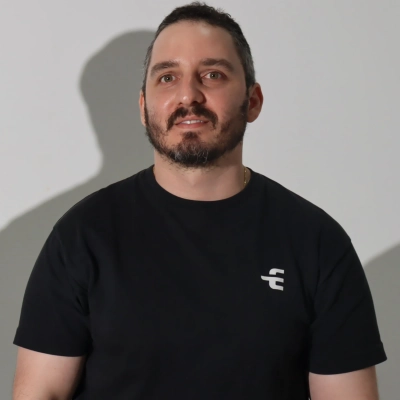16 Ways to Balance Short-Term Tech Needs with Long-Term Strategic Vision
Balancing immediate technology demands with long-term vision requires strategic approaches that top industry experts consistently implement. This article presents sixteen proven methods for organizations to effectively prioritize both urgent needs and future objectives without sacrificing either. Technology leaders share practical frameworks from the RICE model to dependency mapping that help create sustainable technical foundations while addressing pressing business requirements.
Customer-Centric RICE Model Balances Needs
Balancing short-term technology needs with long-term vision requires a structured approach to prioritization. We've found success implementing a customer-centric product development strategy that includes a public board where customers can contribute and upvote product ideas. This input is then evaluated using the RICE prioritization model within our project management system, allowing us to systematically assess each initiative's potential impact. This methodology has proven effective because it combines direct customer feedback with objective evaluation criteria, ensuring we address immediate needs while still advancing our strategic roadmap.
Dedicated Code Improvement Time Builds Trust
I've found that setting aside dedicated time during work weeks specifically for code improvement has been crucial in balancing immediate delivery needs with long-term system health. At my startup, we implemented a systematic approach of first identifying user pain points through probing questions, then simplifying problem statements before brainstorming the most straightforward solutions. This method allowed us to satisfy urgent requirements while still regularly revisiting our codebase to improve its scalability and maintainability. Building team trust was equally important, as it created an environment where anyone could raise critical questions about long-term implications without derailing short-term progress.

Cash Flow First, Then Strategic Tech
In a startup, you start short-term by necessity. Early on, if you don't hit near-term goals, you run out of money, no salaries, no rent, no company. So the first priority is sales and cash flow. As you hit those goals and buy more runway, you earn the right to think longer-term about your tech stack and strategy. It's a balancing act: more runway = more long-term thinking.
On prioritization, my rule is simple, what keeps us alive and moves the main metric now comes first. Once that's stable, we invest in the things that compound (architecture, automation, data). And don't buy into fads. There's a lot of hype, AI included. Ask, is this a real, durable use case for us, or just FOMO? If it's not clearly tied to impact, either immediate survival or long-term leverage, we pass.

Connect Solutions to Five-Year Technology Roadmap
Balancing short-term technology needs with long-term strategic vision requires transparent communication about how immediate solutions connect to broader company goals. We've found success by identifying critical operational gaps first, then evaluating potential solutions against our five-year technology roadmap to ensure alignment. This approach helps prevent investing in temporary fixes that might create technical debt or integration challenges later. Regular reassessment of priorities based on market changes and internal feedback has proven essential to maintaining this balance.
EOS Framework Prevents Revisiting Unresolved Problems
In my experience, using the Entrepreneurial Operating System (EOS) with its IDS process (Identify, Discuss, Solve) has been the most effective for balancing immediate technological needs against our long-term vision.
This structured approach in our weekly core meetings prevents us from continuously revisiting unresolved problems and allows us to clearly prioritise initiatives based on both urgency and strategic alignment.
The "one-touch theory" within this framework has been particularly valuable as our organisation has expanded and our decisions have become increasingly complex and time-sensitive. Having this structured system in place creates the right balance between solving today's technology challenges while keeping us firmly on track toward our long-term objectives.

Phased Rollouts Address Urgent Requirements
In my experience, implementing a phased rollout approach has been the most effective way to balance immediate technology needs with long-term vision. We break down major platform upgrades into manageable phases, which allows us to address urgent requirements while steadily progressing toward our strategic objectives. This methodology incorporates real-time user feedback at each stage, enabling us to make data-driven adjustments while maintaining operational stability.

Three-Bucket Investment Framework Supports Business
In my experience, balancing short-term technology needs with long-term vision requires a structured approach to investment prioritization. I've implemented a framework that categorizes technology investments into three distinct buckets: Regulatory requirements that must be addressed immediately, infrastructure maintenance with upgrade cycles planned years in advance, and strategic R&D investments focused on future competitive technologies. Technology doesn't and shouldn't exist as it's own element, its purpose is to support the business, no matter what that business does. The means, technology strategies and vision should be focused around what is best for the business today and in the future as the future comes up fast and not being prepared has been the downfall of many businesses and executives. My framework ensures we meet immediate business needs while simultaneously building toward our long-term vision. By clearly defining these categories and their respective timelines, we can make more informed decisions about resource allocation and avoid sacrificing future growth for short-term gains.

Allocate Resources Between Customers and Strategy
In my experience, balancing short-term technology needs with long-term vision requires intentional resource allocation. I've found success by designating a specific portion of our product and engineering bandwidth for customer-driven development while maintaining focus on our strategic roadmap. This approach proved particularly valuable during the ChatGPT developer API rollout, where our team's built-in capacity for quick adjustments allowed us to prioritize and release AI integration features ahead of competitors. This balanced methodology strengthens customer relationships while still advancing our long-term technology vision.

Categorize Tasks as Foundational or Differentiating
We balance needs by categorizing every tech request as either "foundational" or "differentiating." Foundational tasks maintain operations, while differentiating ones drive future growth. This simple focus ensures we maintain stability while investing in our long-term strategic goals, avoiding complex matrices.
Short-Term Solutions Build Toward Future Architecture
Short-term requirements serve as essential building blocks for our development process. The company implemented .NET Core services for an enterprise client who required immediate performance enhancements in their legacy .NET system because these services provided both quick results and supported our objective of achieving complete microservices migration. The short-term solutions we implement create progress toward our future architecture design.
Our team uses MoSCoW combined with weighted scoring to prioritize tasks based on business value and tech debt reduction and risk assessment. The approach enables teams to link engineering work to specific business outcomes instead of focusing on time-based targets.

Impact Versus Effort Drives Prioritization
Balancing short-term tech needs with long-term strategy comes down to clarity on what moves the business forward versus what just keeps it running. In practice, I separate initiatives into three buckets: urgent operational fixes, tactical enhancements that improve efficiency, and strategic investments that shape the future of the brand or product.
The method that works best for me is impact versus effort prioritization. For every technology request, we ask: "How much value will this create, and what resources does it require?" This ensures urgent needs are handled quickly without sacrificing projects that have long-term strategic payoff. It keeps the team focused, avoids constant firefighting, and allows us to build scalable systems that support growth rather than just patching problems.

Structural Longevity Test Ensures Future Viability
Balancing short-term technology needs with a long-term strategic vision is like choosing between a quick, cheap patch and a full, quality roof replacement. Both solve an immediate leak, but only one protects the structural future of the business.
My prioritization method has proven most effective because it is simple and hands-on: The Structural Longevity Test.
When a short-term need comes up—like a sudden demand for a new app feature—we don't ask, "How fast can we implement it?" We ask, "Will this hands-on solution be fully functional and structurally sound five years from now, or will it be another piece of legacy rot we have to tear off?"
We faced a choice between a quick, off-the-shelf software solution for hands-on job scheduling and building a custom, modular scheduling component that would take six months longer. The short-term need was to fix the scheduling chaos immediately. However, the long-term vision was to have a system that could seamlessly integrate new technologies, like drone data and material optimization, as they emerged.
We chose the long-term, custom build because the short-term fix would have created a piece of technological rot that would cause a structural failure later. We endured the short-term chaos for six months, but now we have a hands-on scheduling system that is structurally integrated and ready for the next decade of technology. The best prioritization method is applied by a person who is committed to a simple, hands-on solution that always chooses integrity over immediate convenience.
Fix Bottlenecks While Building Scalable Tools
Running a sourcing and manufacturing company, I see technology as both an operational tool and a strategic lever. My method is to prioritize immediate fixes that remove daily bottlenecks, but only commit long-term resources to tools that scale with client demand. This keeps us nimble while still building toward a bigger vision.

Dependency Mapping Reveals Hidden Strategic Priorities
The most effective method has been 'dependency mapping'—prioritizing based on what unblocks the most future work. Before committing to any technology decision, we map what else depends on it. The items with the most downstream dependencies get priority, regardless of their individual urgency.
Example: Building our authentication system wasn't urgent—we had workarounds. But we mapped out that proper authentication would unblock enterprise SSO, role-based permissions, compliance certifications, and audit logging. That one 'boring' infrastructure project unlocked dozens of future capabilities.
This revealed surprising priorities. Our designer workflow tools seemed less critical than client-facing features, but improving designer efficiency impacted every single project flowing through our system. Investing two weeks in better design handoffs saved hundreds of hours across all subsequent work.
The method works because it reveals hidden bottlenecks. That 'small' technical debt isn't small if it blocks ten future features. That 'nice-to-have' developer tool becomes critical when it accelerates everything else. We now process thousands of videos monthly because we prioritized the foundational pieces that everything else required.
Takeaway: Stop prioritizing features in isolation. Map their dependencies and you'll discover that some unsexy infrastructure work is actually your most strategic investment. The highest-impact work often looks boring on a roadmap but enables everything exciting that follows.

Two-Horizon Model Integrates Architecture Assessment
Balancing short-term needs with long-term goals starts with clearly defining what delivers immediate user value versus what enables sustainable growth. I use a two-horizon prioritization model.
Horizon 1 focuses on immediate impact, such as critical bug fixes or high-priority features.
Horizon 2 focuses on strategic enablers like architecture improvements, scalability, and automation.
Before committing to new features, I ensure a thorough understanding of the current system architecture: its performance limits, potential bottlenecks, and maintainability. This allows me to assess whether the system can handle new functionality and scale effectively, or whether incremental refactoring or infrastructure upgrades are needed. By integrating architectural assessments into the prioritization process, we avoid costly technical debt while still delivering value quickly.
In practice, about 70% of each sprint is dedicated to high-impact, user-facing deliverables, and 30% is reserved for technical debt reduction and long-term improvements.

Speed-First Strategy With Protective Guardrails
I balance the short-term and long-term by making "speed-to-value" the default, and putting lightweight guardrails around it (security, data, and architecture). In today's market, the companies that win are the ones that implement technology rapidly, learn in production, and scale what works—without letting speed create irreversible tech or compliance debt. That's consistent with the way you've been positioning cloud and business apps (e.g., "Adapt faster. Work smarter. Perform better.")
A speed-first strategy with guardrails
Commit to speed-to-value as the primary objective.
Give teams permission to ship thin vertical slices to production early (30-60-90-day horizons), then scale what resonates. This isn't "move fast and break things"—it's move fast and measure things, with reversible decisions by default. This is exactly what cloud adoption and modern business platforms enable when used intentionally.
Wrap speed with guardrails, not gates.
Establish minimum bars for identity, data classification, logging, API standards, and IaC. These guardrails keep you safe while shipping fast—so speed doesn't accumulate compliance/security debt that slows you later.
Modernize incrementally (no big-bang rewrites).
Use the Strangler Fig pattern: carve off new capabilities around the legacy core, migrate slice-by-slice, and retire the old gradually—so you deliver value quickly and reduce risk.
The prioritization method that consistently works: Speed-to-Value WSJF
I use a pragmatic hybrid of WSJF (Weighted Shortest Job First) tuned for rapid implementation. WSJF is a proven, lean-economic model that ranks work by Cost of Delay / Duration.
Step 1 — Anchor to a single "speed" outcome
Pick one Metric that reflects customer value realized fast (e.g., Time-to-First-Value, activation within 7 days, % of invoices e-issued within 24h). Keep it a leading indicator of revenue/adoption so teams can optimize for it daily.
Step 2 — Score with WSJF, but weight for speed
Use relative scoring and include two speed-centric tweaks:
Plain TextSpeed-to-Value WSJF score = [(User/Business Value) + (Time Criticality) + (Risk Reduction / Opportunity Enablement)] x (Value Realization Speed Factor) / (Job Size x Integration Complexity)
Step 3 — Plan with Now-Next-Later (time horizons, not dates)
Keep the roadmap flexible and execution-focused. "Now" is in build, "Next" is ready for discovery/teaming, "Later" frames strategic bets






